When
King James VII of Scotland died in 1700, Louis XIV of France
gave his word and his support to the cause of his son, James
VIII, or the "pretender" as he was known to his
enemies. For a long time, the Jacobites as James supporters
were called, (from the Latin for James "Jacobus"),
envisaged him back from exile and in Scotland rallying his
faithful subjects to his standard, and then at the head of
a huge Franco- Scottish army marching south to England to
regain his English crown. This was first attempted in 1708.
but patrolling English warships in the Firth of Forth prevented
a landing. The next attempt came in 1715 when the German King
George I was on the throne, and Scotland had been unsteadily
"allied" to England for eight years.
The cause of King James to claim back the Scottish throne
had support mainly in the Highlands, but there were still
many people ready to fight for James in the Lowland areas
too. However not all the nation was in favour of a restoration
of the exiled Stewarts. whilst there was a great deal of resentment
against England because of the recent union and the way it
had been brought about, there were also powerful religious
arguments which divided opinions, briefly, the Roman Catholics
were for James as were the Episcopalians, whilst the Presbyterians
were resolutely opposed to him.
The Clan Campbell, or the house of
Argyll, had been used to a great extent by the English Government
in the subjugation of surrounding clans, and the Campbell's
policy of gaining wealth, power and status by such means
had earned them bitter hatred. This made enemies of the
Clan join the Jacobites, Stewarts, MacDonalds, MacPhersons
and Robertsons all opposed the Campbells and as such formed
the core of Jacobite strength in the Highlands in 1689,
1715, 1719 and 1745.
James wrote from France in 1715 to
John Erskine, 6th Earl of Mar and secretary of state for
Scotland, urging him to raise the Clans. Now the Earl may
have been the principle supporter of the Jacobite cause,
but he possessed only a small degree of military skill and
tended to drag his feet. However the old Scottish Royal
standard was raised on the 6th of September at Castletown
near Braemar. By the middle of the same month, Mar occupied
Perth with roughly 5,000 men and most of the northern towns,(
Aberdeen, Montrose, Inverness, etc:) had declared for King
James.
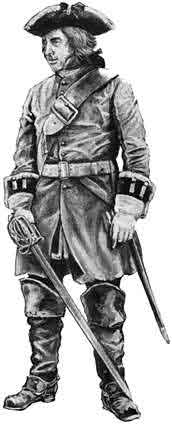 Between
the Earl and England there was a blocking force of 2,300-3,000
Government troops under the command of the very able John
Campbell, 2nd Duke of Argyll, located near Stirling. True
to form Mar refused to leave Perth until he was joined by
Clansmen from the Western Highlands. In early October, word
reached him that further south, border Jacobites were on
the move, led by Lord Kenmure (Scot), lord Derwentwater
(English) and Thomas Forster the MP for Northumberland,
who had raised a token mounted force in King James's name.
The Earl sent 2,000 men south under Brigadier MacKintosh
of Borlum, with the vague brief of co- operating with these
border elements whilst he remained in perth still with the
main part of the army. Between
the Earl and England there was a blocking force of 2,300-3,000
Government troops under the command of the very able John
Campbell, 2nd Duke of Argyll, located near Stirling. True
to form Mar refused to leave Perth until he was joined by
Clansmen from the Western Highlands. In early October, word
reached him that further south, border Jacobites were on
the move, led by Lord Kenmure (Scot), lord Derwentwater
(English) and Thomas Forster the MP for Northumberland,
who had raised a token mounted force in King James's name.
The Earl sent 2,000 men south under Brigadier MacKintosh
of Borlum, with the vague brief of co- operating with these
border elements whilst he remained in perth still with the
main part of the army.
The only viable route south for MacKintosh
was to cross the Firth of Forth, patrolled then as in 1708
by English men of war. MacKintosh assembled a fleet of small
fishing boats in the Fife ports of Anstruther and Pittemweem,
then by staging an attempted crossing from the port of Burntisland
he drew the English warships up the Forth. This allowed
him to transport his 2,000 men under the cover of darkness
to the southern shore of the Forth, landing between Aberlady
and Gullane on the night of 11th of October.
But once he was on the southern shore of the Forth MacKintosh
was tempted by the rich prize of Edinburgh, so after proclaiming
James King at Haddington he turned towards the Capital.
Argyll, informed of this serious threat to the Capital,
made a forced march from his camp at Sterling with 200 infantry
and 300 dragoons. the race to Edinburgh was almost a dead
heat, as MacKintosh arrived at Jock's Lodge. a mile to the
east of the city, Argyll entered the West Port. Frustrated
in his attempt to surprise Edinburgh, MacKintosh turned
north and occupied the citadel of Leith, which he armed
with guns taken from ships in the harbour. Argyll, his small
body of regular troops reinforced by the Edinburgh militia
and volunteers, moved against the citadel and demanded that
the Jacobites surrender, a demand which was rejected with
derision. Neither side was in a position to force a decision,
Argyll lacked artillery and could not afford the casualties
he would have incurred in an attack. MacKintosh though safe
for the time being had lost his chance of taking the Capital,
he now had no chance of receiving supplies or reinforcements
and was in real danger of being blockaded in Leith. Realising
that he could accomplish nothing in this position, MacKintosh
and his 2,000 Highlanders slipped out of Leith by night
and occupied Seton Palace to the east of Edinburgh. After
a few days he reverted to his original plan and marched
south to the Borders to meet the Jacobites operating in
that area. There MacKintosh met up with the forces of Lord
Kenmure and Thomas Forster at Kelso.
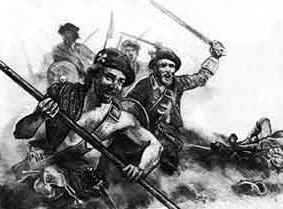 Their
forces now numbered 600 cavalry and 1,400 infantry. This
small force would have been capable of making a significant
contribution to the Jacobite cause if it had been properly
led, but dissension among the leaders led to the ruin of
all. The Scottish leaders wanted to implement Mar's plan
and march west in an attempt to draw Argyll from Sterling,
The English leaders on the other hand wanted to turn south
and confront a force of 900 Government cavalry under George
Carpenter which was moving north to engage them. Either
plan, if successful, would have helped the Jacobite cause,
but neither faction would yield, and both plans were abandoned.
Instead the army moved along the Border to Langholm by way
of Hawick and Jedburgh, and then into England hoping to
attract more recruits as they moved south. Instead they
lost 500 of Mackintosh's Highlanders who refused to leave
Scotland and deserted in a body. Most of these were captured
as they tried to make their way north. As the sadly reduced
Jacobite army moved south they met no real opposition, but
their numbers were not increased by the flood of English
recruits they had been led to expect, practically the only
reinforcement they received was a group of Catholic gentlemen
who joined them at Lancaster. By the 9th of November they
had occupied Preston, where they allowed themselves to be
trapped by General Carpenter's force which had followed
them from the north and which had been reinforced by another
detachment of Government troops under General Charles Wills.
The Jacobites put Preston into a state of defence and for
two days of fierce fighting maintained their position against
the numerically inferior Government troops. But the Jacobite
leaders, discouraged by the lack of support from the people
of northern England and lacking resolution, surrendered
unconditionally. Their
forces now numbered 600 cavalry and 1,400 infantry. This
small force would have been capable of making a significant
contribution to the Jacobite cause if it had been properly
led, but dissension among the leaders led to the ruin of
all. The Scottish leaders wanted to implement Mar's plan
and march west in an attempt to draw Argyll from Sterling,
The English leaders on the other hand wanted to turn south
and confront a force of 900 Government cavalry under George
Carpenter which was moving north to engage them. Either
plan, if successful, would have helped the Jacobite cause,
but neither faction would yield, and both plans were abandoned.
Instead the army moved along the Border to Langholm by way
of Hawick and Jedburgh, and then into England hoping to
attract more recruits as they moved south. Instead they
lost 500 of Mackintosh's Highlanders who refused to leave
Scotland and deserted in a body. Most of these were captured
as they tried to make their way north. As the sadly reduced
Jacobite army moved south they met no real opposition, but
their numbers were not increased by the flood of English
recruits they had been led to expect, practically the only
reinforcement they received was a group of Catholic gentlemen
who joined them at Lancaster. By the 9th of November they
had occupied Preston, where they allowed themselves to be
trapped by General Carpenter's force which had followed
them from the north and which had been reinforced by another
detachment of Government troops under General Charles Wills.
The Jacobites put Preston into a state of defence and for
two days of fierce fighting maintained their position against
the numerically inferior Government troops. But the Jacobite
leaders, discouraged by the lack of support from the people
of northern England and lacking resolution, surrendered
unconditionally.
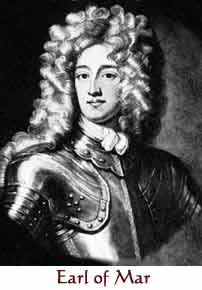 Since
the 11th of October, when MacKintosh had crossed the Forth,
Mar had remained inactive in Perth apart from a half-hearted
move against Sterling on the 16th of October. Argyll had
also remained immobile, he had nothing to gain by taking
the offensive, and the longer he could delay the inevitable
battle, the stronger his army would become. All those who
were prepared to show their hand against the Government
on the other hand, had joined Mar, and he could expect no
further recruits until he had achieved some notable success
which would indicate that the Jacobite cause was likely
to succeed. News that Dutch troops, lent to the British
Government, had landed in England and were marching to join
Argyll, forced Mar's hand, now, before Argyll's army exceeded
his in numerical strength, he had to make his attempt to
force the passage of the Forth and occupy the Lowland counties. Since
the 11th of October, when MacKintosh had crossed the Forth,
Mar had remained inactive in Perth apart from a half-hearted
move against Sterling on the 16th of October. Argyll had
also remained immobile, he had nothing to gain by taking
the offensive, and the longer he could delay the inevitable
battle, the stronger his army would become. All those who
were prepared to show their hand against the Government
on the other hand, had joined Mar, and he could expect no
further recruits until he had achieved some notable success
which would indicate that the Jacobite cause was likely
to succeed. News that Dutch troops, lent to the British
Government, had landed in England and were marching to join
Argyll, forced Mar's hand, now, before Argyll's army exceeded
his in numerical strength, he had to make his attempt to
force the passage of the Forth and occupy the Lowland counties.
Mar's plan was to cross the Forth to
the west of Stirling with his main body, while a smaller
detachment was to make a feint towards the bridge at Stirling
with the object of keeping Argyll occupied. On the 8th of
November the Jacobite army left Perth and on the following
day reached Auchterader, where they were joined by 2,500
Highlanders under General Gordon of Achentoul. It has been
estimated that at this point Mar had between 6,000 and 7,000
infantry and just over 1,000 cavalry. Mar again delayed
and did not move forward until the 12th.
Argyll learnt of the Jacobite move
and having received reinforcements from Glasgow, Falkirk
and Kilsyth, crossed the Forth and moved north to intercept
Mar at Dunblane, an area more suited to the effective use
of cavalry than the marshy valley of the Forth. By the evening
of the 12th, he had deployed his army with its left flank
at Dunblane and his right on Stonehill, an eminence due
east of the town. His position, which covered the road along
which the Jacobites were advancing, was a strong one, his
right flank was protected by boggy ground and his left by
the Allan Water. The Government forces consisted of 1,000
cavalry and 2,500 infantry, with some light artillery, although
the guns were destined to play no part in the coming battle.
The Jacobite advance guard received warning that Dunblane
was occupied by their enemies and halted at Kinbuck, just
over two miles to the north, where they were joined by the
main body. Next morning, 13th of November, preparations
were made for battle. At first light Mar drew up his forces
with his right on Kinbuck facing due south, but when a group
of horsemen from the opposing army were seen reconnoitering
on the ridge of Sheriffmiur to the south-east he decided
to advance and size this high ground inclining his army
to his left. At this point Mar made a momentous mistake
by allowing several squadrons of cavalry, which had previously
been out on the wings, to move around and into the centre,
leaving the right wing with a bare two squadrons and the
left with none.
Order
of Battle, Sherriffmuir
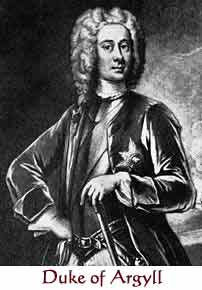 Argyll,
who saw that this move would outflank him on the right,
wheeled his army to meet the threat. Because these manoeuvres
were carried out over rough ground on which it was impossible
for the armies to see each other at great distance, each
side was suddenly confronted by their opponents at short
range before either side had the opportunity of forming
a proper battle line. Argyll had deployed his army in two
lines. His front line consisted of six infantry battalions,
their flanks protected by four squadrons of dragoons on
the left, and three squadrons of dragoons and a squadron
of volunteer horse on the right. his second line consisted
of two infantry battalions flanked by a squadron of dragoons
to left and right. The Jacobite army was also in two ranks,
but their march over the rough ground had thrown then into
considerable disorder and their left flank was unprotected
by cavalry. Argyll,
who saw that this move would outflank him on the right,
wheeled his army to meet the threat. Because these manoeuvres
were carried out over rough ground on which it was impossible
for the armies to see each other at great distance, each
side was suddenly confronted by their opponents at short
range before either side had the opportunity of forming
a proper battle line. Argyll had deployed his army in two
lines. His front line consisted of six infantry battalions,
their flanks protected by four squadrons of dragoons on
the left, and three squadrons of dragoons and a squadron
of volunteer horse on the right. his second line consisted
of two infantry battalions flanked by a squadron of dragoons
to left and right. The Jacobite army was also in two ranks,
but their march over the rough ground had thrown then into
considerable disorder and their left flank was unprotected
by cavalry.
Battle was joined as soon as the two armies came within
range, On Argyll's right the Highland infantry, although
in confusion, opened the attack on their equally ill-prepared
opponents. For a quarter of an hour the issue on this flank
was in doubt, but Argyll in personal command of the Government
right wing, seeing that the Jacobite flank was unprotected,
sent a squadron of the Scots Greys under General Cathcart,
to attack from the right. The Highlanders, under fire from
two sides, fell back and the Duke of Argyll led his five
squadrons of cavalry in pursuit, supported by three infantry
battalions, led by General Wigthman. It was no rout, each
time they were broken the Jacobites rallied again, ten times
said Argyll, and each time they had to be broken again by
the pursuing Government troops. and it was three hours before
the last remnants of Mar's left had been chased over the
Allan Water. General Wightman wrote of them later, "I
never saw regular troops more exactly drawn up in line of
battle, and then in a moment, and their officers behaved
with all the gallantry imaginable".
On the other flank the pattern was
reversed, the Government infantry advancing up the hill
in a confused manner suddenly came face to face with General
Gordon's Highland infantry, whose flank extended far beyond
their own flank, now unprotected by the cavalry squadrons
which had fallen behind. The Highlanders fired two volleys
at close range, then launched a fierce Highland charge which
broke the five battalions on the left of Argyll's line and
drove them back into their own cavalry, completely disorganising
the complete centre and the left wing of the Government
army was driven from the field and pursued towards Sterling.
Colonel Harrison, an eyewitness, declared that in seven
or eight minutes the rout of all Government units was complete.
General Whitham, commanding the Government's left flank,
could not see what was happening on Argyll's flank, all
sight of it was obscured by the smoke of battle and a cloud
of Highlanders pouring through the centre of the Government
army. he could only think that the entire army had been
defeated.
When the Duke of Argyll heard of the
disaster to his left, he gathered the forces he had been
leading in pursuit and marched back towards the field of
battle, Mar recalled the victorious section of his army
from its pursuit and faced about to renew the action. At
this stage the Government army was reduced to about 1,000
infantry and the five squadrons of cavalry from its right
flank plus those from the left flank who had managed to
escape from the fury of the Highlander's charge. The Jacobite
army was reduced to about 4,000 infantry and some cavalry.
Argyll saw that he was out numbered and that his men were
tired, so he established himself in a strong defensive position
behind some turf walls and ditches. here flanked by artillery,
he awaited Mar's attack.
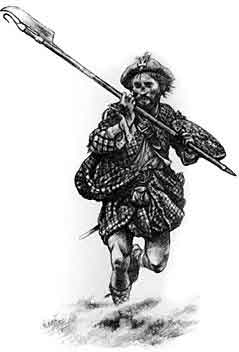 Mar
made no move, he had an overwhelming advantage of numbers
and was still in a position to crush Argyll and win an absolute
victory, but after a show of advancing his nerve faltered
and he failed to press home his attack. It was at this point
that John Gordon of Glenbuchat, commanding a battalion of
Gordon of Achentoul's Highlanders, angry at Mar's lack of
spirit, is said to have exclaimed "Oh for an hour of
Dundee". Mar
made no move, he had an overwhelming advantage of numbers
and was still in a position to crush Argyll and win an absolute
victory, but after a show of advancing his nerve faltered
and he failed to press home his attack. It was at this point
that John Gordon of Glenbuchat, commanding a battalion of
Gordon of Achentoul's Highlanders, angry at Mar's lack of
spirit, is said to have exclaimed "Oh for an hour of
Dundee".
As light failed Argyll withdrew through
Dunblane, gathering up stragglers from the defeated part
of his army, and spent the night on the other side of the
Allan Water. The Earl of Mar, left in possession of the
field and a quantity of military booty including four colours
and 1,500 stand of arms, claimed the victory. Argyll having
captured fourteen colours, five cannon and most important,
the Jacobite supply wagons, also claimed the victory. In
the morning, Argyll, with a body of horse returned to the
field with the intention of renewing the contest, but Mar,
either satisfied with his victory, or fearing to advance
without a supply train and faced by an enemy not totally
destroyed, had withdrawn northwards to reach Perth on the
17th of November.
Although the battle was inconclusive
from a tactical point of view, strategically the Government
forces had achieved their object and Mar had failed. Argyll's
losses had been heavier than Mar's, some 600 killed wounded
or taken prisoner, against about 250 Jacobite casualties,
but he still controlled the crossing of the Forth and could
expect reinforcements which would more than offset his losses.
Mar on the other hand, having achieved nothing and having
little chance of strengthening his army, was back at his
starting point. In fact several Highland leaders from the
north left Perth to defend their territories from the Earl
of Sutherland who had recaptured Inverness on the same day
as the battle of Sheriffmuir. Mar's hopes of final victory
were fading fast, aid from abroad had not materialised and
the defeat at Preston proved that the Jacobites in England
were not prepared to rise in strength.
The Jacobite leaders, seeing their
main army crumbling away, with no prospect of help from
any quarter, and aware that Argyll had been reinforced by
the Dutch contingent and by the victors of Preston, approached
the Duke of Argyll in order to negotiate the terms of a
surrender. Argyll, who was anxious to put down the rebellion
with as little loss of life as possible, (during the battle
he had urged his troops to grant quarter to as many of the
enemy a possible) and who was in sympathy with the Jacobites
over many of the grievances that had led to the rising,
received their overtures favourably. But as the field commander
he had no powers to negotiate and was forced to refer the
matter to the Government, who frightened by the extent of
the uprising, would consider nothing but an unconditional
surrender. The only result of this exchange was that the
Government came to suspect Argyll's zeal and reliability.
Both armies remained static, while
Mar tried to strengthen the defences round Perth. To add
to the Jacobite difficulties in obtaining peace, Prince
James Frances Edward, their proclaimed king, had at last
arrived to join the army. He landed on 22nd of December,
not with supplies and reinforcements as promised, but with
six attendants and one ship. He was received with some enthusiasm
in Aberdeen and Dundee, but his meeting with the army in
Perth, on 9th January 1716, was less happy. Both parties
were disillusioned. The army expected a dashing hero who
would lead them to victory, but found a dignified but cold
and unsmiling young man, the Prince accustomed to the disciplined
French army in which he had served, found an army of rather
less than 5,000 poorly equipped volunteers now lacking in
enthusiasm for his cause.
The King had come too late. If James
had arrived three months earlier at the beginning of the
campaign, the result may have been different. Sympathisers
might have been quicker to take up arms and opponents less
ready to support the Government. Now the position was hopeless.
The Jacobites, faced with the threat of Argyll's army which
had been reinforced and was now equipped with heavy cannon,
decided that they could not hold Perth. On 30th January
they began to retreat by way of Dundee to Montrose. To delay
the advance of the Government forces by denying them supplies
and shelter, orders were given to destroy all the villages
between Stirling and Perth. In the week preceding the evacuation
of Perth, Auchterader, Blackford, Muthill, Dunning and Crieff
were burnt. Harsh weather at the time caused great misery
to the inhabitants of the villages, but this cruel act did
not slow Argyll's advance, and by 4th February the Jacobites
had reached Montrose unmolested. On that day news was received
that Government troops had occupied Arbroath a few miles
to the south. The Jacobite leaders gave orders for the army
to prepare to march to Aberdeen early the next morning,
but when day came it was discovered that the Prince, the
Earl of Mar, Earl of Melfort, Lord Drummond and a few others
had boarded a ship in the harbour and had sailed for France.
The rising was over, the remnants of
the deserted army marched north to Aberdeen and thence to
Badenoch where each man made his own way home, if he thought
he could remain undiscovered, or into exile if he feared
the consequence of his actions. All that remained was for
the army to disarm the Clans that had supported the Stewarts,
and for the Government to exact retribution from its defeated
opponents.
Argyll was hailed as the saviour of
the country by the Scottish Whigs, but the Government was
far from satisfied. Argyll's reluctance to shed the blood
of his countrymen unnecessarily and his support of the Jacobite
plea for negotiations made the Government distrust his motives.
he was replaced as commander of the army by General William
Cadogan, an Irishman who had served with distinction under
Marlborough and had been in command of the Dutch troops
who had joined Argyll after Sheriffmuir. He had no fellow
feeling for the Jacobites or sympathy for their complaints,
and had been urging Argyll to take stronger action. After
Argyll's departure he commanded the army in a march through
the Highlands, with the object of eradicating the last vestige
of opposition. By May 1716 all was quiet, the disaffected
Clans had laid down their arms and their leaders were in
hiding or had fled overseas. The rebellion was finally over.
Article cobbled together, by
Allan Bryan-Tansley, from various books and articles, the
main source being a wee booklet from the Scottish portrait
gallery, this was published in 1965.
|






